The 1935 Ascot Gold Cup: English Filly Quashed v US Triple Crown Winner Omaha
By Kimberly French
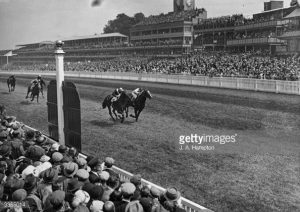 According to an article in England’s Observer, it was the greatest race of all time. It pitted an Epsom Oaks winning filly against a US Triple Crown winner and roughly 150,000 people packed the stands to witness this historic event. The event was the 1935 Ascot Gold Cup and after a scintillating stretch battle between these two tremendous champions, it was the English filly, Quashed, that got her nose down on the wire to defeat the American stallion Omaha. Omaha, however, lost not one iota of esteem from the British public by not hitting the line in front.
According to an article in England’s Observer, it was the greatest race of all time. It pitted an Epsom Oaks winning filly against a US Triple Crown winner and roughly 150,000 people packed the stands to witness this historic event. The event was the 1935 Ascot Gold Cup and after a scintillating stretch battle between these two tremendous champions, it was the English filly, Quashed, that got her nose down on the wire to defeat the American stallion Omaha. Omaha, however, lost not one iota of esteem from the British public by not hitting the line in front.
“To see Quashed and Omaha battle out the finish of the Ascot Gold Cup took years off a man’s life, though it was well worth it,” wrote Jack Leach, a former jockey turned scribe.
The first leg of the British Stayers Triple Crown, the Ascot Gold Cup is held on the third day of the Royal Ascot Meet at the facility which bears its name and was instituted in 1807. The race is two and a half miles long on the turf. The first edition was witnessed by none other than King George III and Queen Charlotte. It also held such renown it was attended by Nicholas I of Russia on his state visit to England in 1844.
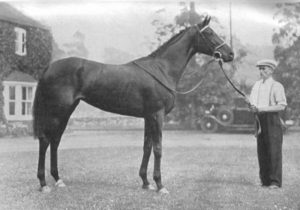 That sojourn by Russian royalty was nearly 100 years before Omaha and Quashed put on their performance, but the race had certainly not lost any of its luster. In fact, Omaha’s owner and breeder William Woodward Sr., had always wanted his horse, the only Triple Crown winner to be sired by a Triple Crown victor (Gallant Fox), to compete on European soil.
That sojourn by Russian royalty was nearly 100 years before Omaha and Quashed put on their performance, but the race had certainly not lost any of its luster. In fact, Omaha’s owner and breeder William Woodward Sr., had always wanted his horse, the only Triple Crown winner to be sired by a Triple Crown victor (Gallant Fox), to compete on European soil.
After his 3-year-old campaign was cut short in August due to an undisclosed injury, Omaha was rested and then transferred from the care of his conditioner Sunny Jim Fitzsimmons to Aqueduct under the watchful eye of English trainer Cecil Boyd Rochefort. The horse was then transported by ship to Newmarket with the goal being a victory in the Ascot Gold Cup. No American horse had captured the race since Foxhall in 1882.
With jockey Pat Beasley holding the lines, Omaha triumphed in the Victor Wild Stakes at Kempton Park Racecourse over a mile and half on May 9. A month later, he returned to Kempton Park for the two mile Queen’s Plate, which he annexed over Lord Derby’s colt Bobsleigh.
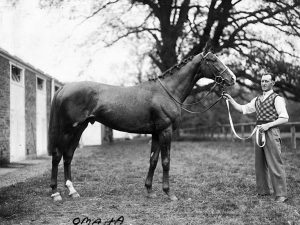 By virtue of his Triple Crown championship and his two English victories, Omaha was sent off as the 11/8 favorite against nine rivals on June 18. It was thought his main competition would come from the filly Quashed, who was an outstanding stayer.
By virtue of his Triple Crown championship and his two English victories, Omaha was sent off as the 11/8 favorite against nine rivals on June 18. It was thought his main competition would come from the filly Quashed, who was an outstanding stayer.
Prior to the horses lining up at the gate, Omaha was very fractious and nearly unseated Beasley on several occasions. In stark contrast Quashed never turned a hair and was as quiet as a church mouse. The contest officially commenced at 2:30 pm over a soft course from morning rain.
“Neither Quashed nor Omaha figured in the running for the first half mile,” stated the Middlesboro Times. “Omaha, obviously full of run, was held in restraint behind Quashed for a full two miles while the front runners Baron Rothschild’s Chaudiere and Lord Glanlay’s Buckleigh enjoyed themselves. At the mile and a half mark the leaders must have been 10 lengths ahead, but when Quashed and Omaha set sail, they quickly rocketed to the lead.”
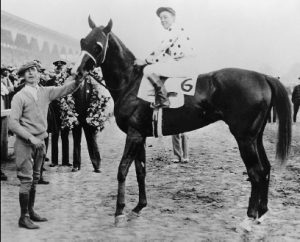 Going into the final turn, Quashed was poetry in motion. Her stride was smooth and reaching as she glided over the turf, but Omaha caught her with a fast and furious rush.
Going into the final turn, Quashed was poetry in motion. Her stride was smooth and reaching as she glided over the turf, but Omaha caught her with a fast and furious rush.
“A furlong from home Omaha brought his nose exactly even with his rival’s, but Quashed refused to give another inch,” stated the Middleboro Times. “Then Omaha quickly dropped by a length as they reached the incline in front of the judges. He could never quite close the gap again, although in the split second before the wire it appeared he was making up ground again.”
According to eyewitness accounts, the crowd became quite restless as they could not tell who had won and did not post the result for some time. Some reports claim the margin of Quashed’s victory was a head, others a nose, but she won by the narrowest of margins. Oddly enough, the filly was not even considered to be a Thoroughbred at that time because pedigree research questioned if her dam was a registered member of the breed.
Other accounts claim Omaha gave the filly weight, but there are no published reports of how much Omaha carried that day. The champion only started one more time before injury concluded his career. He was second by a neck to Taj Akbar in the Princess of Wales Stakes at Newmarket Racecourse the following month. In that contest he did give the winner eighteen pounds as he carried a 138 pound impost.
The goal for Omaha prior to his early retirement was once again the Ascot Gold Cup the following year and in an odd twist of fate, or by Woodward’s dedication to bringing home that particular trophy, his full brother Flares won the 1938 edition of the Gold Cup.
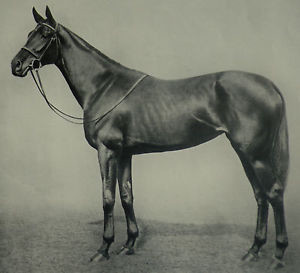 Not much is known about the conclusion of Quashed’s career or what transpired during her retirement. Omaha initially stood at Claiborne Farm, the place of his birth, but was deemed not to be a top class sire. He became the property of the Jockey Club Breeding Bureau in 1943 and eventually was bred in New York for seven years. In 1950 he was transferred to Porter Orchards Farm in Nebraska City, roughly 45 minutes outside of Omaha, where he remained until his death at age 27 in 1959. He was buried at Ak-Sar-Ben Racetrack, where he was paraded and continued to breed a small number of mares.
Not much is known about the conclusion of Quashed’s career or what transpired during her retirement. Omaha initially stood at Claiborne Farm, the place of his birth, but was deemed not to be a top class sire. He became the property of the Jockey Club Breeding Bureau in 1943 and eventually was bred in New York for seven years. In 1950 he was transferred to Porter Orchards Farm in Nebraska City, roughly 45 minutes outside of Omaha, where he remained until his death at age 27 in 1959. He was buried at Ak-Sar-Ben Racetrack, where he was paraded and continued to breed a small number of mares.
“It was his time I suspect,” Morton Porter, the horse’s groom told Steve Haskin of The Blood Horse of his death. “I really missed him. He had become a part of the family, and I have so many fond memories of him. I loaded him on a truck and took him to Ak-Sar-Ben, where he was buried right near the grandstand, with a stone monument and wooden grave marker. When the track built a clubhouse addition, the excavation was going to be right over the site where he was buried. We decided not to exhume the body and move it; this was the track he loved and where he was meant to be. They moved his monument and marker to the Circle of Champions near the grandstand entrance and displayed them there until the track closed down (in 1996).”
Bangor On Dee Racecourse
https://www.bangorondeeraces.co.uk/








